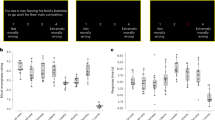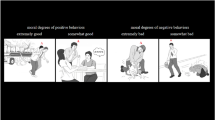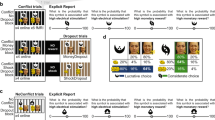Abstract
Identifying the neural mechanisms of moral cognition is especially difficult. In part, this is because moral cognition taps multiple cognitive sub-processes, being a highly distributed, whole-brain affair. The assumptions required to make progress in identifying the neural constituents of moral cognition might simplify morally salient stimuli to the point that they no longer activate the requisite neural architectures, but the right experiments can overcome this difficulty. The current evidence allows us to draw a tentative conclusion: the moral psychology required by virtue theory is the most neurobiologically plausible.
This is a preview of subscription content, access via your institution
Access options
Subscribe to this journal
Receive 12 print issues and online access
$189.00 per year
only $15.75 per issue
Buy this article
- Purchase on Springer Link
- Instant access to full article PDF
Prices may be subject to local taxes which are calculated during checkout




Similar content being viewed by others
References
Hooker, B. Ideal Code, Real World: A Rule–Consequentialist Theory of Morality (Oxford Univ. Press, New York, 2000).
Hill, T. Human Welfare and Moral Worth: Kantian Perspectives (Oxford Univ. Press, New York, 2002).
Broadie, S. Ethics With Aristotle (Oxford Univ. Press, New York, 1991).
Hursthouse, R. On Virtue Ethics (Oxford Univ. Press, New York, 1999).
Munzel, G. F. Kant's Conception of Moral Character: The 'Critical' Link of Morality, Anthropology, and Reflective Judgment (Univ. Chicago Press, Chicago, 1999).
De Waal, F. Good Natured: The Origins of Right and Wrong in Humans and Other Animals (Harvard Univ. Press, Cambridge, 1996).
Greene, J. D. & Haidt, J. How (and where) does moral judgment work? Trends Cogn. Sci. 6, 517–523 (2002).
Casebeer, W. D. Natural Ethical Facts: Evolution, Connectionism, and Moral Cognition (MIT Press, Cambridge, Massachusetts, 2003).
Hume, D. A Treatise of Human Nature (Clarendon, Oxford, 1739/1985).
Moore, G. E. Principa Ethica, Revised Edition (Cambridge Univ. Press, New York, 1994).
Greene, J. From neural 'is' to moral 'ought': what are the moral implications of neuroscientific moral psychology? Nature Rev. Neurosci. 4, 847–850 (2003).
Saver, J. L. & Damasio, A. R. Preserved access and processing of social kowledge in a patient with acquired sociopathy due to ventromedial frontal damage. Neuropsychologia 29, 1241–1249 (1991).
Bechara, A., Damasio, A. R., Damasio, H. & Anderson, S. W. Insensitivity to future consequences following damage to human prefrontal cortex. Cognition 50, 7–15 (1994).
Damasio, A. R. Descartes' Error: Emotion, Reason, and the Human Brain (G. P. Putnam and Sons, New York, 1994).
Anderson, S. W., Bechara, A., Damasio, H., Tranel, D. & Damasio, A. R. Impairment of social and moral behavior related to early damage in human prefrontal cortex. Nature Neurosci. 2, 1032–1037 (1999).
Bauer, L. O. & Hesselbrock, V. M. P300 decrements in teenagers with conduct problems: implications for substance abuse risk and brain development. Biol. Psychiatry 46, 263–272 (1999).
Moll, J. et al. The neural correlates of moral sensitivity: a functional magnetic resonance imaging investigation of basic and moral emotions. J. Neurosci. 22, 2730–2736 (2002).
Moll, J., de Oliveira-Souza, R., Bramati, I. E. & Grafman, J. Functional networks in emotional moral and nonmoral social judgments. Neuroimage 16, 696–703 (2002).
Hamann, S. B., Ely, T. D., Hoffman, J. M. & Kilts, C. D. Ecstasy and agony: activation of the human amygdala in positive and negative emotion. Psychol. Sci. 13, 135–141 (2002).
Adolphs, R., Tranel, D. & Damasio, A. R. The human amygdala in social judgment. Nature 393, 470–474 (1998).
Montague, P. R. et al. Hyperscanning: simultaneous fMRI during linked social interactions. Neuroimage 16, 1159–1164 (2002).
Van Veen, V. et al. Anterior cingulate cortex, conflict monitoring, and levels of processing. Neuroimage 14, 1302–1308 (2001).
Van Veen, V. & Carter, C. S. The timing of action-monitoring processes in the anterior cingulate cortex. J. Cogn. Neurosci. 14, 593–602 (2002).
Bunge, S. A. et al. Prefrontal regions involved in keeping information in and out of mind. Brain 124, 2074–2086 (2001).
MacDonald, A. W. III, Cohen, J. D., Stenger, V. A. & Carter, C. S. Dissociating the role of the dorsolateral prefrontal and anterior cingulate cortex in cognitive control. Science 288, 1835–1838 (2000).
Baron-Cohen, S. Mindblindness: An Essay on Autism and Theory of Mind (MIT Press, Cambridge, Massachusetts, 1995).
Rizzolatti, G., Fogassi, L. & Gallese, V. Neurophysiological mechanisms underlying the understanding and imitation of action. Nature Rev. Neurosci. 2, 661–670 (2001).
Call, J. Chimpanzee social cognition. Trends Cogn. Sci. 5, 388–393 (2001).
Adolphs, R. Cognitive neuroscience of human social behaviour. Nature Rev. Neurosci. 4, 165–178 (2003).
Haidt, J. The emotional dog and its rational tail: a social intuitionist approach to moral judgment. Psychol. Rev. 108, 814–834 (2001).
Greene, J. D. et al. An fMRI investigation of emotional engagement in moral judgment. Science 293, 2105–2108 (2001).
Moll, J., de Oliveira-Souza, R. & Eslinger, P. J. Morals and the human brain: a working model. Neuroreport 14, 299–305 (2003).
Fuster, J. M. Cortex and Mind: Unifying Cognition (Oxford Univ. Press, New York, 2002).
Churchland, P. S. Brain-wise: Studies in Neurophilosophy (MIT Press, Cambridge, Massachusetts, 2002).
Churchland, P. M. Towards a cognitive neurobiology of the moral virtues. Topoi 17, 83–96 (1998).
Wallis, J. D., Anderson, K. C. & Miller, E. K. Single neurons in prefrontal cortex encode abstract rules. Nature 411, 953–956 (2001).
Casebeer, W. D. & Churchland, P. S. The neural mechanisms of moral cognition: a multiple-aspect approach to moral judgment and decision-making. Biol. Philos. 18, 169–194 (2003).
Moreno, J. D. Neuroethics: an agenda for neuroscience and society. Nature Rev. Neurosci. 4, 149–153 (2003).
Cacioppo, J. T. et al. (eds) Foundations in Social Neuroscience (MIT Press, Cambridge, Massachusetts, 2002).
Rachels, J. The Elements of Moral Philosophy 4th Edn (McGraw-Hill, Columbus, 2002).
Lapsley, D. Moral Psychology (West-view, Boulder, 1996).
Acknowledgements
I thank P. M. Churchland and P. S. Churchland for their close reading of the manuscript and invaluable advice about its structure and content. In addition, J. Greene's sceptical remarks were extremely helpful. J. Moll also provided useful preprints of his team's work in this area.
Author information
Authors and Affiliations
Related links
Related links
FURTHER INFORMATION
MIT Encyclopedia of Cognitive Sciences
Rights and permissions
About this article
Cite this article
Casebeer, W. Moral cognition and its neural constituents. Nat Rev Neurosci 4, 840–846 (2003). https://doi.org/10.1038/nrn1223
Issue Date:
DOI: https://doi.org/10.1038/nrn1223
This article is cited by
-
What makes full artificial agents morally different
AI & SOCIETY (2024)
-
On the computational complexity of ethics: moral tractability for minds and machines
Artificial Intelligence Review (2024)
-
Artificial virtuous agents: from theory to machine implementation
AI & SOCIETY (2023)
-
Artificial virtuous agents in a multi-agent tragedy of the commons
AI & SOCIETY (2022)
-
Surveying Ethics: a Measurement Model of Preference for Precepts Implied in Moral Theories (PPIMT)
Review of Philosophy and Psychology (2022)



